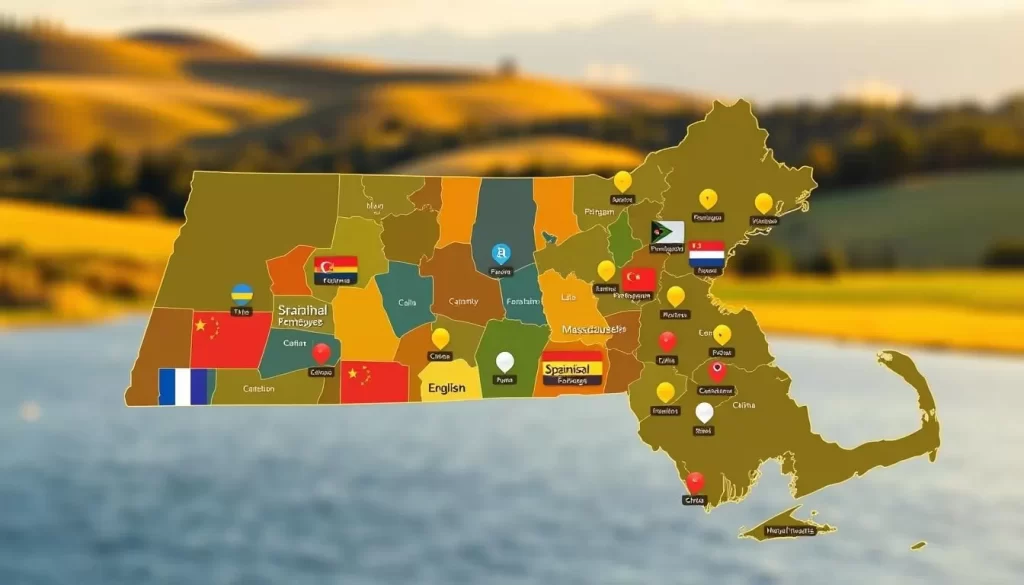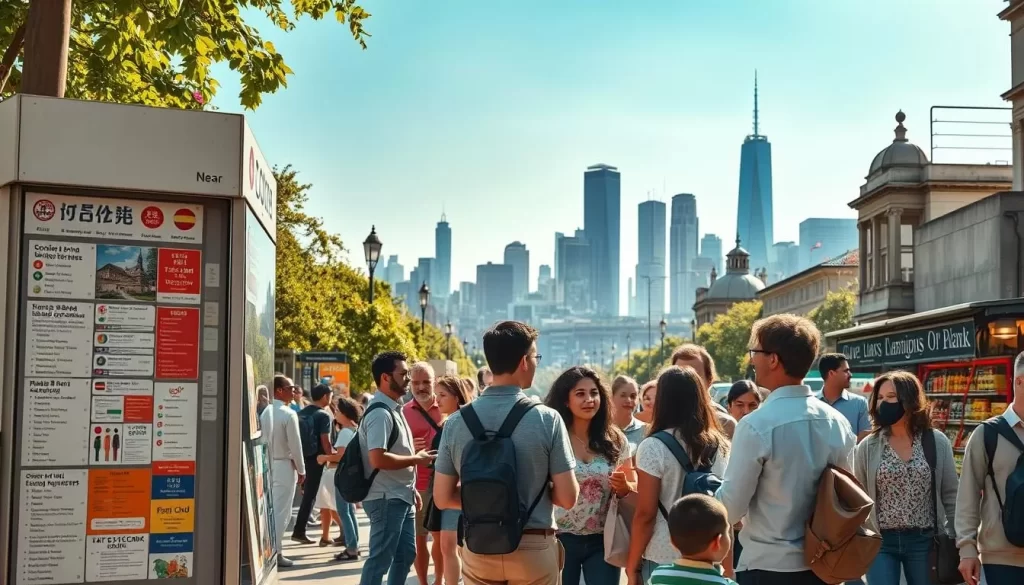✓ Accommodations ✓ Flights ✓ Rental Cars
As you explore the linguistic landscape of Massachusetts, you’ll discover a state with a rich tapestry of languages. While English is not formally declared as the official language, a 1975 Massachusetts Supreme Court ruling (Commonwealth v. Olivo) made it the de facto official language.
Approximately 24% of households in Massachusetts speak a language other than English at home, representing around 635,000 households. This diversity reflects the state’s complex immigration history and cultural heritage, making it one of America’s most linguistically diverse states.
Understanding the language diversity in Massachusetts provides valuable insights into the state’s demographic composition and the changing face of American society.
The Linguistic Landscape of Massachusetts
With a significant portion of the population speaking languages other than English at home, Massachusetts showcases a vibrant multilingual environment. You can explore this diversity by examining the role of English and other languages spoken in the state.
English as the De Facto Official Language
English serves as the de facto official language in Massachusetts, established through legal precedent rather than explicit legislation. A pivotal ruling in the 1975 case of Commonwealth v. Olivo functionally made English the official language. As a result, English is predominantly used in official contexts, government services, and public education.
Multilingual Households in Massachusetts
Approximately 24 percent of households in Massachusetts speak a language other than English at home. With about 2.647 million households in the state, this translates to around 635,000 households using a different language during a crucial part of daily life. The multilingual landscape reflects the state’s rich immigration history and its role as a destination for international communities. Language data shows that these households tend to cluster in specific communities and urban centers, forming an essential part of Massachusetts’ cultural identity.

Understanding this linguistic diversity helps policymakers, educators, and service providers better address the needs of diverse populations throughout Massachusetts.
Historical Immigration Patterns and Language Evolution
As you explore the history of Massachusetts, you’ll find that immigration patterns have significantly influenced its linguistic landscape. The state’s language profile is a rich tapestry woven from the threads of various cultures and immigration waves.
Indigenous Languages and Early Settlement
Initially, Massachusetts was inhabited by indigenous people, with Algonquian-speaking natives being a substantial part of the population around 1000 CE. The arrival of English settlers in the 17th century marked the beginning of a new linguistic era, gradually displacing native languages.
European Immigration Waves
By the 1840s, Irish immigrants fleeing the Potato Famine brought their distinctive dialects, contributing to the linguistic diversity. Subsequent waves of immigration introduced languages such as French, Italian, Greek, and Portuguese, particularly during the late 19th century, shaping the linguistic diversity of the region.
Modern Immigration and Linguistic Diversity
The Immigration Act of 1924 temporarily slowed the influx, but later shifts in immigration laws and the internal migration of African Americans in the 1950s brought new dialects and speech patterns. Today, Massachusetts is one of the most linguistically diverse places in the United States, with languages from around the world being spoken.
| Immigration Wave | Primary Languages Introduced | Time Period |
|---|---|---|
| Indigenous Peoples | Algonquian | Pre-17th Century |
| English Settlement | English | 17th Century |
| European Immigration | Irish, French, Italian, Greek, Portuguese | 19th-Early 20th Century |
| Modern Immigration | Various Global Languages | Late 20th Century-Present |
Top 10 Non-English Languages Spoken in Massachusetts
The linguistic diversity of Massachusetts is reflected in the top 10 non-English languages spoken by its residents. As you explore the languages that shape the state’s cultural identity, you’ll discover a vibrant tapestry of cultures and languages.
Spanish
Spanish is the most widely spoken non-English language in Massachusetts, with more than 632,230 residents (9.67% of the population) using it in their daily lives. This significant presence is a result of historical and ongoing immigration from Spanish-speaking countries.
Portuguese
Portuguese holds a strong second position, with approximately 206,232 speakers (3.15% of residents). This reflects significant immigration from Portugal, Brazil, and other Portuguese-speaking countries, contributing to the state’s cultural fabric.
Chinese (Mandarin and Cantonese)
Chinese languages, including both Mandarin and Cantonese, rank third with around 148,270 speakers (2.27% of the population). These languages are primarily concentrated in urban areas, where the Chinese community has established significant cultural and economic presence.
Haitian Creole
Haitian Creole has a surprisingly strong presence, with about 89,731 speakers (1.37%). This makes Massachusetts home to one of the largest Haitian diaspora communities in the United States.
French
French (including Cajun dialects) maintains historical significance, with around 49,442 speakers (0.76%). This legacy stems from French-Canadian immigration to the state.
Vietnamese
Vietnamese has 41,986 speakers (0.64%), representing a distinct immigrant community that has contributed to the state’s cultural diversity.
Russian
Russian is spoken by approximately 37,092 people (0.57%), reflecting the presence of a Russian-speaking community in Massachusetts.
Arabic
Arabic has about 33,369 speakers (0.51%), indicating a significant Arabic-speaking population in the state.
Hindi
Hindi is spoken by around 29,277 residents (0.45%), contributing to the linguistic diversity of Massachusetts.
Italian
Italian rounds out the top ten with 24,347 speakers (0.37%). This reflects the historical presence of Italian immigrants in the state.
As you can see from the data, the distribution of these top languages varies significantly across different regions of Massachusetts. Certain communities serve as cultural hubs for specific language groups.

| Language | Number of Speakers | Percentage of Population |
|---|---|---|
| Spanish | 632,230 | 9.67% |
| Portuguese | 206,232 | 3.15% |
| Chinese | 148,270 | 2.27% |
| Haitian Creole | 89,731 | 1.37% |
| French | 49,442 | 0.76% |
| Vietnamese | 41,986 | 0.64% |
| Russian | 37,092 | 0.57% |
| Arabic | 33,369 | 0.51% |
| Hindi | 29,277 | 0.45% |
| Italian | 24,347 | 0.37% |
Massachusetts, United States: Official and widely spoken languages by Region
As you explore the diverse linguistic landscape of Massachusetts, you’ll discover that language patterns vary significantly across different regions. The state’s linguistic diversity is shaped by its history, immigration patterns, and geographical characteristics.
Boston’s Linguistic Diversity
Boston stands as a major hub of linguistic diversity, with neighborhoods like East Boston, Chinatown, and Dorchester hosting concentrated language communities. In East Boston, you’ll find a vibrant Spanish-speaking community, while Chinatown maintains Cantonese and Mandarin as everyday languages. Dorchester features significant Cape Verdean Creole and Vietnamese-speaking populations.

Language Communities in Western Massachusetts
Western Massachusetts presents a different linguistic landscape, with cities like Springfield and Holyoke hosting substantial Spanish-speaking communities. The Berkshires region maintains distinct language communities, particularly among older residents who preserved their heritage languages.
Coastal and Island Language Patterns
The coastal regions and islands, including Cape Cod, Martha’s Vineyard, and Nantucket, have unique language patterns. Portuguese is particularly prominent in some fishing communities due to historical immigration from the Azores and mainland Portugal. These regional language patterns influence local businesses and community services, with translation needs varying significantly across different parts of the state.
Language Access and Services in Massachusetts
Massachusetts leads the way in providing language services to its diverse population. The state’s commitment to language access is evident in its comprehensive policies and programs designed to serve residents with limited English proficiency.
Translation and Interpretation Services
The translation and interpretation services in Massachusetts have evolved significantly, now offering sophisticated solutions such as on-demand phone interpretation and professional document translation. This evolution caters to the growing needs of the state’s linguistically diverse community.
Language Access in Healthcare and Education
Healthcare facilities and educational institutions in Massachusetts are required to provide language access services. Hospitals must translate vital documents into the most common languages spoken in their areas, while schools offer programs for English language learners and communicate with parents in their native languages.
Government and Legal Language Accommodations
The Massachusetts court system and government agencies provide language accommodations, including interpretation services and translated materials, to ensure that all residents can access essential public services. This approach reflects a broader trend across the United States towards greater inclusivity.

| Service | Description | Beneficiaries |
|---|---|---|
| Translation Services | Professional document translation and on-demand phone interpretation | Residents with limited English proficiency |
| Language Access in Healthcare | Translation of vital documents into common languages | Patients in healthcare facilities |
| Language Access in Education | Programs for English language learners and native language communication | Students and parents |
Conclusion: The Future of Linguistic Diversity in Massachusetts
The future of language in Massachusetts is being rewritten by changing demographics and technological advancements. As new immigrant communities establish themselves, the state’s linguistic diversity is set to increase, with languages from Asia, Africa, and Latin America likely to grow in prominence.
Technology will play a crucial role in addressing language needs, with digital translation tools and remote interpretation services making it easier for Massachusetts residents to access essential services.
As the state’s linguistic landscape continues to evolve, it will maintain its position as a global connector, reflecting broader national patterns while developing its unique character.
The above is subject to change.
Check back often to TRAVEL.COM for the latest travel tips and deals.






